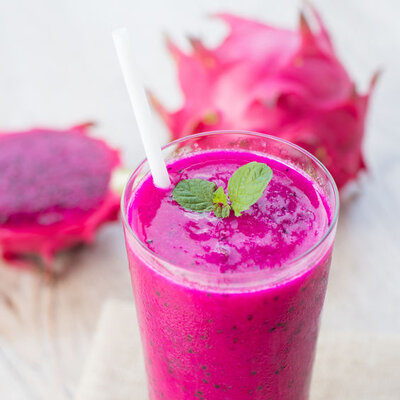
Dragon Fruit Juice
also known as Pitaya juice, Pitahaya juice, Strawberry Pear juice
What is Dragon Fruit Juice?
Dragon fruit juice is the liquid extract from the dragon fruit of the Cactaceae family. Dragon fruit can have a pinkish-red or yellow peel, gives off a slightly sweet flavor and the insides can be:
- white
- pink
- red
This fruit is cultivated in tropical and subtropical areas of the world, such as Southeast Asia, Australia, Mesoamerica, the Caribbean, and the US. In the United States, only three states commercially produce this fruit: California, Florida, and Hawaii. The increased demand for dragon fruit in the US has led to the importation of this fruit from Ecuador, Colombia, and Nicaragua.
Some American varieties of dragon fruit include:
- Alice
- American Beauty
- Bloody Mary
- Cosmic Charlie
- Dark Star
- David Bowie
- Delight
- Halleys Comet
- L.A. Woman
- Neitzl
- Physical Graffiti
- Purple Haze
- Red Jaina
- Seoul Kitchen
- Thompson
- Voodoo Child
- Yellow Dragon
Origin of dragon fruit juice
The origin of juicing can be traced back to 150 BC when records indicate that early humans were mashing fruits together to attain their juices. However, according to Aztec literature, the dragon fruit only appeared in the 13th century. This fruit is believed to be native to Central America from where it was likely transported to Europe by European colonizers. The French are credited with introducing the dragon fruit to Vietnam, where it soon became an important crop.
In the 1930s, raw food advocate Dr. Norman Walker invented the juicing machine, which made juicing more accessible. This led to a slow, but steady rise of Americans consuming more juices, including dragon fruit. This trend continued into the 1990s and juice soon converted itself into a worldwide industry. During the early 2000s, the rise of diets and special exercise routines made juicing even more popular. These days, dragon fruit and its juice are consumed all over the world.
Nutrition
This fruit juice has many of the same vitamins and minerals as the dragon fruit including vitamin C, iron, and magnesium. A 3.5 ounce serving contains:

This tropical fruit juice also has plenty of antioxidants, such as betalains, hydroxycinnamates, and flavonoids. Some potential health benefits associated with dragon fruit juice are improved gut health, healthy weight management, and reduced insulin resistance. However, this juice may not be suitable for everyone, considering some individuals may be allergic to dragon fruit.
Commercial Production
The commercial production of fruit juices begins with sorting and washing the fruits. Next, the dragon fruit is crushed into a pulp and its skin is separated from the flesh. Then, the pulpy flesh that is squeezed to extract its juices. Extraction is done with industrial machines for optimal results. Next, this juice can be pasteurized, bottled, capped, labeled, and stored until it’s ready to be sold.
Use
Storing dragon fruit properly will ensure that your dragon fruit juice is fresh and flavorful. When refrigerating, it’s best to keep this fruit at a temperature of 50°F. This will allow you to keep the whole fruit for up to two weeks. If you store dragon fruit at room temperature, it will only last about 3-4 days. This will be best when freshly made, however you can store it in an airtight container in the fridge. This juice should be consumed within 24 – 72 hours after juicing, as oxidation will render it undrinkable after that.
Dragon fruit juice recipes
This fruit juice can bring a tropical flavor to any juice blend. Here are some popular recipes:
- Dragon Fruit Juice
- Dragon Fruit and Pear Juice
- Dragon Fruit Smoothie
- Dragon Fruit Juice Cooler
- Dragon Fruit Smoothie Bowl
FDA Regulations
The Food & Drug Administration heavily regulates fresh fruits and how they should be cultivated, prepared, and packaged but has no standard of identity for dragon fruit. Nonetheless, the FDA regulates the production of juice, which it defines as the “aqueous liquid expressed or extracted from one or more fruits or vegetables, purees of the edible portions of one or more fruits or vegetables”. The FDA goes on to describe how these juices should be labeled to comply with their regulations.
References
“Dragon Fruit.” Agrmc.org, Agricultural Marketing Resource Center, www.agmrc.org/commodities-products/fruits/dragon-fruit.
“Overall Dragon Fruit Production and Global Marketing.” Ap.fftc.org, FFTC Agricultural Policy Platform (FFTC-AP), 16 July 2020, ap.fftc.org.tw/article/1596.
“Dragon Fruit.” Dragonfruitpitaya.org, Dragon Fruit, dragonfruitpitaya.org/.
Tan, Bonny, et al. “Dragon Fruit.” Infopedia, National Library Board Singapore, 16 Apr. 1999, eresources.nlb.gov.sg/infopedia/articles/SIP_768_2005-01-11.html.
“Dragon Fruit.” Agmrc.org, Agricultural Marketing Resource Center, 1 Oct. 2018, www.agmrc.org/commodities-products/fruits/dragon-fruit.
“Guide on Microbial Hazards of Fresh-Cut Fruits and Vegetables.” U.S. Food and Drug Administration, FDA, 1 Feb. 2008, www.fda.gov/regulatory-information/search-fda-guidance-documents/guidance-industry-guide-minimize-microbial-food-safety-hazards-fresh-cut-fruits-and-vegetables.
